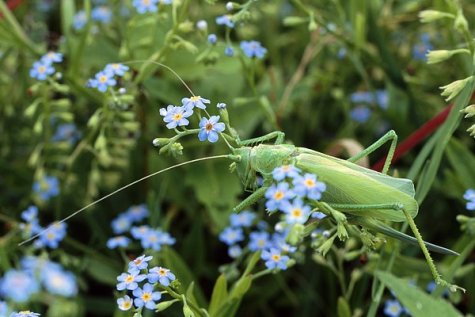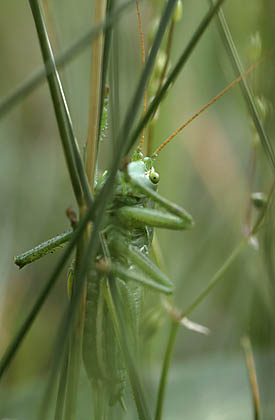"Singer" in summer nights
Photos: Arne Ader
Nature sound: Veljo Runnel
Translation: Liis
Bush cricket on water forget-me-not
You are missing some Flash content that should appear here! Perhaps your browser cannot display it, or maybe it did not initialize correctly.
| Bush cricket, singing cricket | Harilik lauluritsikas |
Adult crickets are a great deal bigger than grasshoppers. The antennae are thin and longer than the cricket itself. The body is stocky, legs long but somehow seem clumsy because the heavy body doesn’t allow long jumps.
The bush cricket or singing cricket is probably the best known. It occurs in all of mainland Estonia (not present on our islands) and has a very loud voice. Brightly green coloured, with some brown on the back, the powerful bush cricket is certainly noticeable; body length can be more than three centimetres. To generate the sound the male crickets rub the lower parts of the wing sheaths against each other. Researchers have discovered that the sound will change according to the circumstances. For female crickets a calling sound is produced and a melody of content that sounds “softer“ when a female cricket is close by. When a second male cricket is nearby a “war song“ is produced that is particularly sharp and strident ...
The female cricket is easy to distinguish by its long and sturdy ovipositor, tapered at the end, at the rear of the abdomen (see lower photo).
The singer in the bush is quite hard to find. The green colour and the wings, similar to leaves, make the cricket nearly invisible. The singing cricket can often be heard from quite high up, even the top of a ten metres high tree can suit them. This sharp, loud “end of summer song“ we can hear into late night.
Grasshoppers are mainly animal eaters, they hunt for smaller insects, invertebrates and sometimes smaller specimens of the own tribe. There are nine species of crickets in Estonia.
Bush cricket in grass










